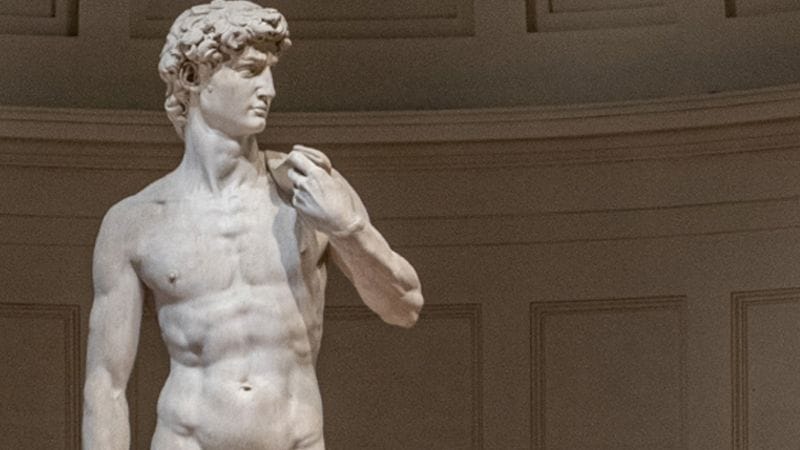Editor’s Note: The following contains minor spoilers about “Black Panther: Wakanda Forever.” CNN — In “Black Panther: Wakanda Forever,” the aquatic adversary known as Namor wastes no time establishing himself as one
This Italian icon suddenly looks different
Editor’s Note: Sign up to CNN Travel’s free nine-part Unlocking Italy newsletter for insider intel on Italy’s best loved destinations and lesser-known regions to plan your ultimate trip. Plus, we’ll get you in the mood before you go with movie suggestions, reading lists and recipes from Stanley Tucci.
CNN
—
For over 500 years, Michelangelo’s sculpture of David in Florence has stood unchanged, the marble icon of masculinity, and one of the world’s most famous works of art.
But as Italy emerges from the pandemic, the David has got a whole new look.
A new lighting system has revolutionized how the famous statue looks, with small details visible for the first time in its history.
“A few days ago, I noticed muscles on the body that I’d never seen before,” says Lucia Lazic, a guide who visits the Accademia Gallery most days.


Michelangelo’s David in the Accademia Gallery.
Emilio Fraile/NurPhoto/Getty Images/Guido Cozzi
“I said, ‘What on earth? How have I never seen this?’ The lighting is much better on the David.”
Cecilie Hollberg, director of the Accademia, said in a statement that the lighting has “changed the visual perception of the artworks,” telling CNN that the David’s marble looks “whiter” and that the details are “more visible.”
The lighting – completed in September as part of works that were unveiled this week – aimed to bring the “dynamism of sunlight” into the Tribuna room where the statue is kept under a domed skylight.
LED spotlights were installed in a circle above the statue, allowing them to “completely envelop the David and leave the rest of the space in the background.”
The color of the light changes imperceptibly during the day, while the spotlights are of varying warmth, allowing visitors to get a new perspective with every step around the statue.

The new-look David is part of a wider revamp of the museum, which was Italy’s second most visited in 2019.
The Galleria dei Prigioni, or “prisoners corridor” – named after Michelangelo’s four semi-finished sculptures of prisoners of war, which share the space with two of his other works – has also had its lighting switched up, with several spotlights pointed on each sculpture.
“It used to be that the prisoners looked yellow, and David was white. Now they’re the same color,” Hollberg told CNN.
“You can now see every chisel mark on them.”
The new lighting system, which “restores the right balance of chiaroscuro and color to the works,” is also energy-efficient. Hollberg says the gallery should use around 80% less electricity than in previous years.
It’s not just the headline works that are looking different. Several of the other rooms of the gallery have had their previously beige walls painted in colors that maximize those in the paintings.
The Sala del Colosso, the gallery’s first room, is now a bright blue, while the 13th and 14th-century rooms are a pale green, chosen to bring out the gold used in most of the paintings.


Sala Colosso in the Accademia Gallery
Guido Cozzi
And the new lighting everywhere has transformed the paintings from things tourists used to rush past en route to David, to unmissable in their own right.
“One regular visitor said, ‘Where was all this detail? We never saw it,’” Hollberg told CNN. “In one painting by Domenico Ghirlandaio you can now see all the gold dots in the [saints’] halos. Before, the beige walls flattened the gold. In another, it feels like you could pluck the pearls from the painting – before you couldn’t see them at all.
“My job is to give value and visibility to all the works. Every single work here is a masterpiece, but works die on a beige background – they need to be lifted and supported by color. I want to give them what they deserve.”

In the past, the lighting was so bad that some paintings were barely visible – like those beside the David. “Before it was all dark, you couldn’t see them – no one stopped,” said Hollberg. One time she saw a guide shining their phone torch on another painting in a bid to show it to visitors.
Tourists have already changed their behavior, she said.
“Now they stop and look. They’re not all in front of the David like before. I’ve followed groups, and they used to cut through the Sala del Colosso and never stop. Now I see that room full of visitors – it’s redistributing the crowds.”
Lazic, a guide with Elite Italian Experience, agrees: “There are more people stopping in the Sala del Colosso.”
The renovations, which started just before the pandemic and which have been rolled out this year, have finished with the revamp of the Gipsoteca. The plaster cast gallery was another rush-through place. That’s if it was open – with no open windows or air conditioning, it used to close at midday during the summer.
But now with air conditioning, powder blue walls and a new layout for the 414 plaster casts – mostly done by sculptor Lorenzo Bartolini, whose works are found in the Louvre, Amsterdam’s Rijksmuseum and the Metropolitan Museum of Art – it’s a place to linger.
Hollberg says that locals are starting to appreciate the museum, too. “Before it was a space for tourists, but Florentines are rediscovering it. We got the last resisters in with a concert series.”
Dario Franceschini, Italy’s minister of culture, called the reopening of the Gipsoteca “an important step… in bringing [the Accademia] into the 21st century.”
He added: “The works across the entire building have allowed significant innovations in the systems, transforming a museum conceived in the late 19th century into a modern venue without distorting it.”
Don't Miss
CNN — Ferrari’s miserable season has gone from bad to worse as the Italian manufacturer failed to get either car
To tackle Thailand’s mounting trash problem, one company is turning to the country’s plant life. Universal Biopack makes packaging that
CNN — Lewis Hamilton may be Formula One’s most successful driver but after securing a record-equaling seventh world title on

Editor’s Note: The following contains minor spoilers about “Black Panther: Wakanda Forever.”
CNN
—
In “Black Panther: Wakanda Forever,” the aquatic adversary known as Namor wastes no time establishing himself as one of those beguiling but strange characters that can polarize an audience: the ocean-dwelling deity uses conch shells like smartphones and has feathered wings on his ankles.
But as portrayed by Mexican actor Tenoch Huerta Mejía in this brooding follow up to 2018’s “Black Panther,” Namor also commands considerable gravitas as the amphibious leader of an underwater tribe, and deserves more than just the inevitable comparisons he will receive to his DC counterpart, Aquaman. (CNN, DC Films and Warner Bros, which produced “Aquaman,” are part of the same parent company, Warner Bros. Discovery.)
Historically, DC predates Marvel with almost all of its legacy characters in the pages of the comic books that made them famous: Superman (1938) came well before Iron Man (1963), Batman (1939) before Moon Knight (1975), Wonder Woman (1941) before Captain Marvel (1968), and so on. It’s the ultimate of ironies that Namor is only appearing in the Marvel Cinematic Universe now, since he is one of the few Marvel Comics characters to have come first.
Also known as the Sub-Mariner, Namor first appeared in comics in 1939, while DC’s Aquaman debuted in 1941. Of course, on the big screen, the opposite is true: DC managed to beat Marvel to the punch in the realm of underwater superheroes, releasing “Aquaman” in 2018 and introducing the character played by Jason Momoa in “Batman v Superman: Dawn of Justice” two years before that. What’s more, “Aquaman” remains one of DC’s biggest hits: the movie has made over $1 billion globally over its lifetime, according to Box Office Mojo, with a sequel on the way next year.
Marvel and “Wakanda Forever” director Ryan Coogler therefore had their work cut out for them to ensure Namor and his world created a wow factor, while also diverging enough from what had been done before, namely in “Aquaman.” And to the new film’s credit, it appears as though much if not all of the sequences showing the underwater kingdom of Talokan — with citizens playing waterlogged ballgames and hanging around on benches — utilizes actual underwater photography and divers, as opposed to CGI.
In Mejía — who is billed as being “introduced” in “Wakanda Forever,” despite over 70 credits in Mexican cinema spanning 15 years as well as last year’s “The Forever Purge” — Marvel thankfully has found its own dynamic anchor to this new underwater world. The character’s menacing presence and intimidation is tempered only by the vulnerability, even torture, in his expression, adding yet another element that differs from the quirky and tongue-in-cheek nature of Momoa’s aquatic superhero.
“Black Panther: Wakanda Forever” also had the daunting task of presenting Namor’s origins in a way that swam clear of those seen in “Aquaman,” and of doing it in a movie not meant to operate solely as an origin story.
Both Namor and Aquaman claim the mythic Atlantis as their points of origin in their respective comic book source material — and DC already used Atlantis as their setting for “Aquaman” four years ago — so there was a ripe opportunity to change things up when it came to Namor’s backstory in “Wakanda Forever.” The change comes by way of Talokan, Namor’s home kingdom, which is inspired by Mesoamerican, Indigenous Central and South American mythology. The switch to this Mayan and Aztec-based setting allows the movie to explore histories of colonization that are much more rooted in reality, similar to how the original “Black Panther” touched on Africa’s historical struggle with colonizers, as well.
Arguably, the most notable deviation from Namor’s comics origin comes in a reveal made in the film: the aquatic superbeing seems to be the result of a tribal ritual using a mystical herb, much like how the Black Panther is manifested. (Aquaman, meanwhile, draws his superpowers from one parent of royal Atlantean heritage.) But then, the movie goes even further — on the eve of Phase V of the MCU’s grandmaster plan, Namor utters in no uncertain terms that he is “a mutant,” a clear siren call of things to come, with the mutant X-Men — previously inhabiting a separate 20th Century Fox franchise — soon to be incorporated into the MCU fold.
But before that happens, and thanks to Mejía’s nuanced performance in “Wakanda Forever,” Namor should be able to avoid many more comparisons to other oceanic demigods, and ride his own wave into the future.
Don't Miss
Editor’s Note: Sign up to CNN Travel’s free nine-part Unlocking Italy newsletter for insider intel on Italy’s best loved destinations






